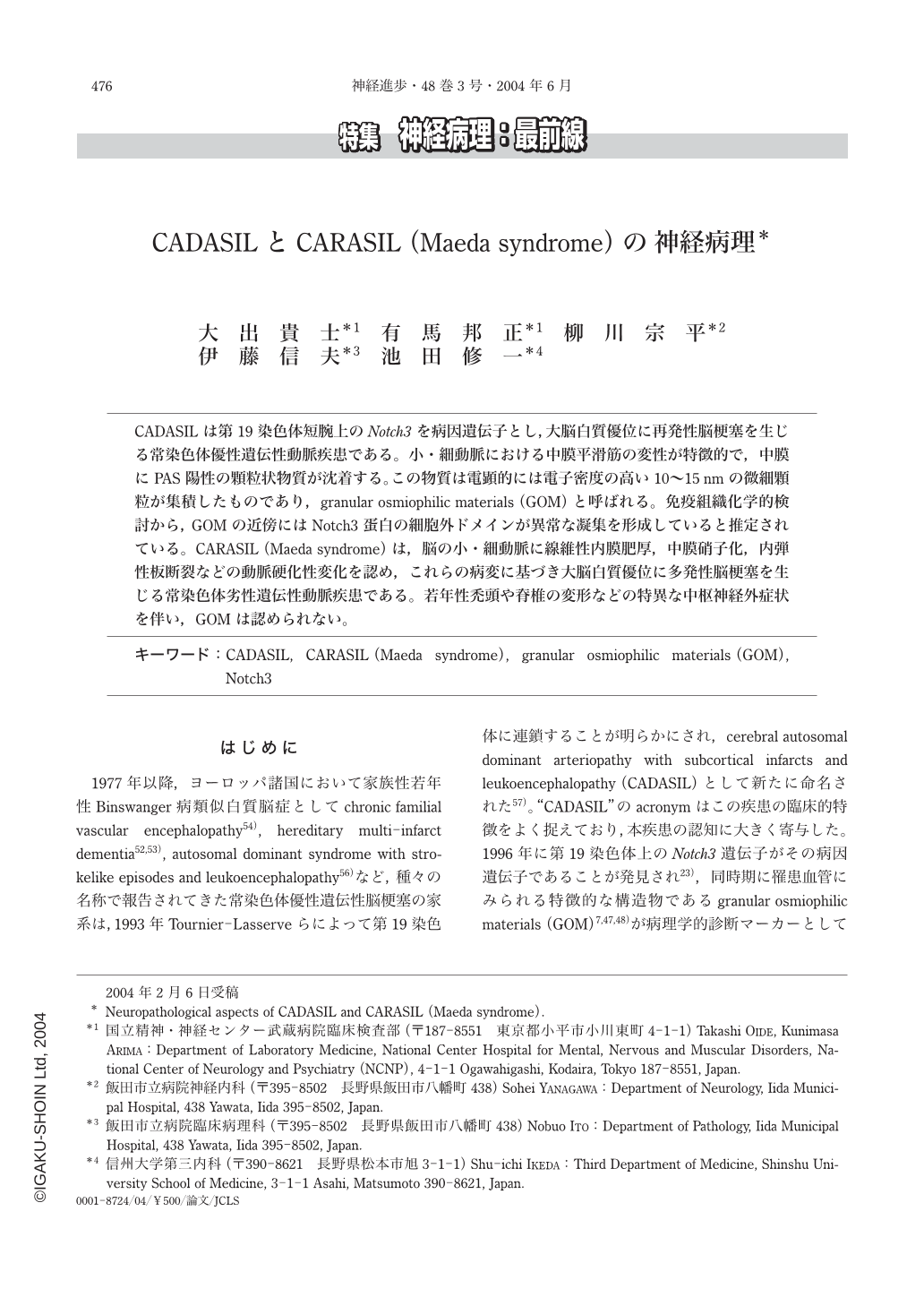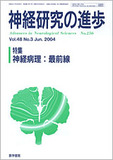Japanese
English
- 有料閲覧
- Abstract 文献概要
- 1ページ目 Look Inside
CADASILは第19染色体短腕上のNotch3を病因遺伝子とし,大脳白質優位に再発性脳梗塞を生じる常染色体優性遺伝性動脈疾患である。小・細動脈における中膜平滑筋の変性が特徴的で,中膜にPAS陽性の顆粒状物質が沈着する。この物質は電顕的には電子密度の高い10~15nmの微細顆粒が集積したものであり,granular osmiophilic materials(GOM)と呼ばれる。免疫組織化学的検討から,GOMの近傍にはNotch3蛋白の細胞外ドメインが異常な凝集を形成していると推定されている。CARASIL(Maeda syndrome)は,脳の小・細動脈に線維性内膜肥厚,中膜硝子化,内弾性板断裂などの動脈硬化性変化を認め,これらの病変に基づき大脳白質優位に多発性脳梗塞を生じる常染色体劣性遺伝性動脈疾患である。若年性禿頭や脊椎の変形などの特異な中枢神経外症状を伴い,GOMは認められない。
Two inherited cerebrovascular diseases developing in non-hypertensive young or middle-aged adults with no other vascular risk factors are described in the present report.
Cerebral autosomal dominant arteriopathy with subcortical infarcts and leukoencephalopathy(CADASIL)is caused by single missense mutations or small deletions in Notch3 gene encoding a transmembrane receptor, Notch3. In adults, Notch3 is expressed only in vascular smooth muscle cells and it may promote cell survival by inhibiting apoptosis. CADASIL presents with migraine with aura in approximately one-third of patients. More severe symptoms of recurrent strokes that preferentially affect the cerebral subcortical white matter usually appear at 30 to 50 years of age. Histopathologically, CADASIL is characterized by the deposition of smudged periodic acid-Schiff(PAS)-positive granular materials in the tunica media of small arteries and arterioles. Electron microscopically, each particle of the PAS-positive materials can be visualized as tightly aggregated, electron dense fine granules, 10-15nm in size, known as“granular osmiophilic materials(GOM)”. GOM can be detected within the vascular walls of muscle and skin biopsy samples, suggesting that CADASIL is a systemic vascular disease. The medial smooth muscle cells are degenerated and completely lost, especially in smaller arteries less than 100microns in diameter. Destruction of the vascular smooth muscle cells can be demonstrated by immunostaining for smooth muscle actin. Although the intima of the affected arteries and arterioles shows fibrosis or hyalinosis, luminal occlusion is rarely seen. Conversely, most of the affected arteries are dilated and exhibit a so-called“earthen pipe state”as a result of the degeneration of the medial smooth muscle cells. These vascular changes lead to multiple lacunar infarcts and diffuse leukoencephalopathy. When examined using Notch3-immunohistochemistry, the tunica media shows intense and granular immunopositivity for Notch3 ectodomains. On immunoelectron microscopic examinations, Notch3 immunolabeling is detected at the cytoplasmic membrane of vascular smooth muscle cells in close vicinity to GOM, whereas the GOM themselves are not labeled by anti-Notch3 antibodies. GOM has so far been regarded as the pathological hallmark of CADASIL;however, the exact composition of GOM has not been completely identified. Recently, vascular smooth muscle cells have come to be considered as the primary target in the cascade of events leading from Notch3 mutations to CADASIL arteriopathy.
Cerebral autosomal recessive arteriopathy with subcortical infarcts and leukoencephalopathy(CARASIL)is a form of young-adult onset arteriosclerotic leukoencephalopathy without hypertension that is frequently accompanied by extra-central nervous system symptoms, such as alopecia and lumbago. The disorder is considered to be inherited in an autosomal recessive fashion. Histopathologically, CARASIL is characterized by intense arteriosclerosis without GOM deposition, leading to multiple small infarcts in the basal ganglia and brainstem and diffuse leukoencephalopathy. Arteriosclerotic changes are most intense in the cerebral white matter and basal ganglia. Small arteries in the leptomeninges and brainstem are also affected to a lesser degree. Fibrous intimal proliferation, hyaline degeneration of the media, thickening and splitting of the internal elastic lamina, and concentric narrowing of the lumen are characteristic features. In PAS preparations, small arteries are occasionally stained homogeneously as a result of exudative changes but never exhibit the granular appearance that is characteristic of GOM.
Although both CADASIL and CARASIL share the common clinical and neuroradiological features of multiple cerebral infarction and leukoencephalopathy, the background of the cerebrovascular pathology in these two condis-copic examinations, Notch3 immunolabeling is detected at the cytoplasmic membrane of vascular smooth muscle tions is quite different. In addition, the constellation of extra-central nervous system symptoms mentioned above is highly specific for CARASIL. Thus, CARASIL appears to be a distinctive disease entity that is clearly distinguishable from CADASIL. Ever since its first description, CARASIL has been reported exclusively in Japan, suggesting that CARASIL is less recognized and possibly overlooked or confused with CADASIL in other countries. The authors suggest that this entity be referred to as“Maeda syndrome”or“CARASIL(Maeda syndrome)”to avoid confusion with CADASIL.

Copyright © 2004, Igaku-Shoin Ltd. All rights reserved.


